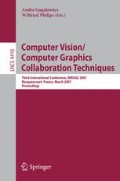Abstract
In this paper we present a method for fast energy minimization of virtual garments. Our method is based upon the idea of multi-resolution particle system. When garments are approximately positioned around a virtual character, their spring energy may be high, which will cause instability or at least long execution time of the simulation. An energy minimization algorithm is needed; if a fixed resolution is used, it will require many iterations to reduce its energy. Even though the complexity of each iteration is O(n), with a high resolution mass-spring system, this minimization process can take a whole day. The hierarchical method presented in this paper is used to reduce significantly the execution time of the minimization process. The garments are firstly discretized in several resolutions. Once the lowest resolution particles system is minimized (in a short time), a higher resolution model is derived, then minimized. The procedure is iterated up to the highest resolution. But at this stage, the energy to minimize is already much lower so that minimization takes a reasonable time.
Access this chapter
Tax calculation will be finalised at checkout
Purchases are for personal use only
Preview
Unable to display preview. Download preview PDF.
References
Baraff, D., Witkin, A.: Large Steps in cloth simulation. In: Cohen, M. (ed.) SIGGRAPH 98 Conference Proceedings, Annual Conference Series, Orlando, Florida, USA, July 1998, pp. 43–54. ACM Press, New York (1998)
Lafleur, B., Magnenat Thalmann, N., Thalmann, D.: Cloth Animation with Self Collision Detection. In: Proceedings IFIP Conference on Modeling in Computer Graphics, Tokyo, pp. 179–187. Springer, Heidelberg (1991)
Bridson, R., Fedkiw, R., Anderson, J.: Robust treatment of collisions, contact and friction 106 for cloth animation. ACM Transactions on Graphics, SIGGRAPH 2002 21 (2002)
Breen, D.E., House, D.H., Wozny, M.J.: Predicting the drape of woven cloth using interacting particles. In: SIGGRAPH ’94, pp. 365–372 (1994)
Capell, S., et al.: A Multiresolution Framework for Dynamic Deformations. In: ACM SIGGRAPH, ACM Press, New York (2002)
Capell, S., et al.: Interactive Skeleton-Driven Dynamic Deformations. In: ACM SIGGRAPH, ACM Press, New York (2002)
Choi, K.-J., Ko, H.-S.: Stable but responsive cloth. ACM Transactions on Graphics, SIGGRAPH 2002 21 (2002)
Chouraqui, P., Elber, G.: Physically Based Adaptive Triangulation of Freeform Surfaces. In: CGI’96,, Los Alamitos, CA, USA, p. 144 (1996)
Decaudin, P., et al.: Virtual Garments: A Fully Geometric Approach for Clothing Design. Computer Graphics Forum (EUROGRAPHICS 2006) 25(3) (2006)
Eberhardt, B., Etzmuß, O., Hauth, M.: Implicit-explicit schemes for fast animation with particle systems. In: Eurographics Computer Animation and Simulation Workshop (2000)
Feynman, C.: Modeling the Appearance of Cloth. Master’s thesis, Dept. of EECS, Massachusetts Inst. of Technology, Cambridge, Mass. (1986)
Fuhrmann, A., Gross, C., Luckas, V.: Interactive animation of cloth including self collision detection. Journal of WSCG 11(1), 141–148 (2003)
Gross, C., Fuhrmann, A., Luckas, V.: Automatic pre-positioning of virtual clothing. In: Proceedings of the 19th spring conference on Computer Graphics, Budmerice, Slovakia, pp. 99–108 (2003)
House, D.H., Breen, D.E. (eds.): Cloth Modeling and Animation. A.K. Peters, Wellesley (2000)
Hutchinson, D., Preston, M., Hewitt, T.: Adaptive Refinement for Mass/Spring Simulations. In: Computer Animation and Simulation9́6, pp. 31–45 (1996)
Jain, N., et al.: Multi-resolution collision handling for cloth-like simulations. Computer Animation and Virtual Worlds 16(3-4), 141–151 (2005)
Weil, J.: The Synthesis of Cloth Objects. Computer Graphics (Proceeding SIGGRAPH’86) 20(4), 49–54 (1986)
Ju, X., Werghi, N., Siebert, P.: Automatic segmentation of 3d human body scans. In: IASTED International Conference on Computer Graphics and Imaging, CGIM 2000, pp. 239–244 (2000)
Ng, H.N., Grimsdale, R.L.: Computer techniques for modeling cloth. Computer Graphics and Applications 16(5), 28–41 (1996)
Kang, Y.-M., Cho, H.-G.: Bilayered approximate integration for rapid and plausible animation of virtual cloth with realistic wrinkles. In: Computer Animation 2002, Geneva, Switzerland, p. 203 (2002)
Thanh, T.L., Gagalowicz, A.: Virtual cloth pre-positioning. In: Proceedings of Mirage 2005 (March 2005)
Li, L., Volkov, V.: Cloth animation with adaptively refined meshes. In: ACSC ’05: Proceedings of the Twenty-eighth Australasian conference on Computer Science (2005)
Metzger, J., Kimmerle, S., Etzmuß, O.: Hierarchical techniques in collision detection for cloth animation. Journal of WSCG 11(2), 322–329 (2003)
Meyer, M., et al.: Interactive animation of cloth-like objects for virtual reality. The Journal of Visualization and Computer Animation 12, 1–12 (2001)
Zhang, D., Yuen, M.M.F.: Collision detection for clothed human animation. In: Proceedings of the 8th Pacific Graphics Conference on Computer Graphics and Application, pp. 328–337 (2000)
Provot, X.: Deformation Constraints in a Mass-Spring Model to Describe Rigid Cloth Behavior. In: Proc. Graphics Interface ’95, pp. 147–154 (1995)
Provot, X.: Collision and self-collision handling in cloth model dedicated to design garments. In: Graphics Interface 97, pp. 177–189 (1997)
Chittaro, L., Corvaglia, D.: 3D Virtual Clothing: from Garment Design to Web3D Visualization and Simulation. In: Web3D’03: Proceeding of the 8th international conference on 3D Web technology, Saint Malo, France, p. 73 (2003)
Press, W.H., et al.: Numerical Recipes. The art of scientific Computing. Cambridge University Press, Cambridge (1992)
Terzopoulos, D., et al.: Elastically Deformable Models. Computer Graphics, 205–214 (July 1987)
van den Bergen, G.: Efficient collision detection of complex deformable models using AABB trees. Journal of Graphics Tools 2 (1998)
Author information
Authors and Affiliations
Editor information
Rights and permissions
Copyright information
© 2007 Springer Berlin Heidelberg
About this paper
Cite this paper
Le Thanh, T., Gagalowicz, A. (2007). Fast Virtual Cloth Energy Minimization. In: Gagalowicz, A., Philips, W. (eds) Computer Vision/Computer Graphics Collaboration Techniques. MIRAGE 2007. Lecture Notes in Computer Science, vol 4418. Springer, Berlin, Heidelberg. https://doi.org/10.1007/978-3-540-71457-6_13
Download citation
DOI: https://doi.org/10.1007/978-3-540-71457-6_13
Publisher Name: Springer, Berlin, Heidelberg
Print ISBN: 978-3-540-71456-9
Online ISBN: 978-3-540-71457-6
eBook Packages: Computer ScienceComputer Science (R0)

